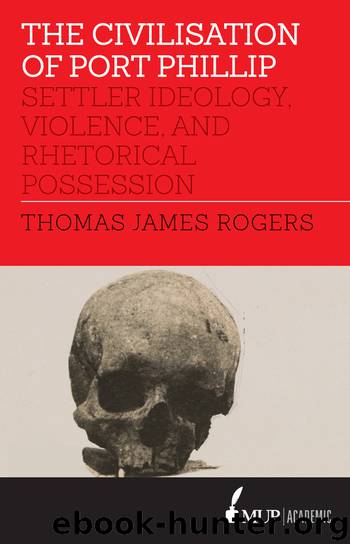The Civilisation of Port Phillip: Settler Ideology, Violence, and Rhetorical Possession by Thomas James Rogers

Author:Thomas James Rogers [James Rogers, Thomas]
Language: eng
Format: epub
ISBN: 9780522870602
Google: W63EswEACAAJ
Publisher: Melbourne University Publishing
Published: 2018-02-23T01:05:15.528000+00:00
The lawyers and their questions
Joseph Tice Gellibrand was a solicitor in London for six years before applying to Earl Bathurst, the Secretary of State for the Colonies, for the newly created position of Attorney-General of Van Diemen’s Land in May 1823.17 He arrived in the colony in March 1824 with his wife Isabella, three children, two servants, a clerk, and his father William.18 His original intention was to hold the office of Attorney-General concurrently with a private solicitor’s practice, as he thought this to be ‘usual in the Colonies’.19 Bathurst expressed concern to a mutual acquaintance that Gellibrand was taking up the post with the primary objective of personal gain, rather than as a service to the colony, and as a result Gellibrand offered his assurance that he would not take up private practice.20 Despite keeping this promise, Gellibrand was to fight charges of misconduct during his short time as Attorney-General. Gellibrand was opposed to many of Lieutenant Governor George Arthur’s policies, and the friction between the two eventually led to an inquiry into his conduct being commissioned by Arthur. Ultimately, Gellibrand was removed from office without any right of appeal. Gellibrand’s association with Robert Murray, a newspaper editor critical of Arthur, probably did not help his cause, but his contemporaries and historians since have concluded that he was legally in the right.21
After his dismissal from office, Gellibrand established himself as an attorney at private practice in Hobart. His opposition to the policies of Lieutenant Governor Arthur continued unabated. On 1 November 1828, Arthur had declared martial law in the ‘settled districts’ of the island—an area including the corridor of land between Hobart and Launceston. Historians have understood this declaration as the official declaration of the ‘Black War’ in Van Diemen’s Land.22 A newspaper report of a public meeting in 1830 illustrates Gellibrand’s deep legal concerns about this war Lieutenant Governor Arthur was waging on the Aboriginal Tasmanians. The meeting was held to establish a town guard for Hobart composed of men who could not go to the interior of the island to participate in what would later be known as the ‘Black Line’. Gellibrand noted that fleeing Aboriginal people were likely to be shot, and he queried the justice of killing the innocent with the guilty. He appeared more concerned, however, that those who killed Aboriginal people in the course of the operation could be tried for murder.23 To this the Attorney-General, Alfred Stephen, would give no answer. Stressing that he spoke as a private citizen, Stephen said that those assembled owed protection to the class of people who had been sent as convicts to Van Diemen’s Land, many of whom found employment in the interior; therefore, regarding Aboriginal people, ‘capture them if you can’, he counselled, ‘but if you cannot destroy them’.24
Less information can be found about George Hesse. In March 1833 he announced his intention to practise as a lawyer in the Supreme Court of Van Diemen’s Land, and by May he was practising.25 Interestingly, like Gellibrand, there is also a public record of Hesse questioning fundamental aspects of colonial law.
Download
This site does not store any files on its server. We only index and link to content provided by other sites. Please contact the content providers to delete copyright contents if any and email us, we'll remove relevant links or contents immediately.
| Africa | Americas |
| Arctic & Antarctica | Asia |
| Australia & Oceania | Europe |
| Middle East | Russia |
| United States | World |
| Ancient Civilizations | Military |
| Historical Study & Educational Resources |
The Songlines by Bruce Chatwin(2125)
The Fatal Shore by Robert Hughes(996)
Origins to Eureka by Thomas Keneally(718)
11 The Bear And The Dragon by Tom Clancy(617)
A Commonwealth of Thieves: The Improbable Birth of Australia by Thomas Keneally(602)
Eureka to the Diggers by Thomas Keneally(583)
Australia 1901 - 2001 by Andrew Tink(579)
A Commonwealth of Thieves by Thomas Keneally(567)
Shoot Straight, You Bastards! by Nick Bleszynski(539)
Dark Emu by Bruce Pascoe(533)
The Penguin History of New Zealand by Michael King(501)
Carnivorous Nights: On the Trail of the Tasmanian Tiger by Margaret Mittelbach; Michael Crewdson; Alexis Rockman(495)
James Cook by Peter Fitzsimons(493)
Venom by Brendan James Murray(486)
The Book Of Ian Watson by Ian Watson(485)
The Tall Man by Chloe Hooper(429)
The Golden Country by Tim Watts(400)
Murder on Easey Street by Helen Thomas(399)
Australian History for Dummies by Alex McDermott(371)
